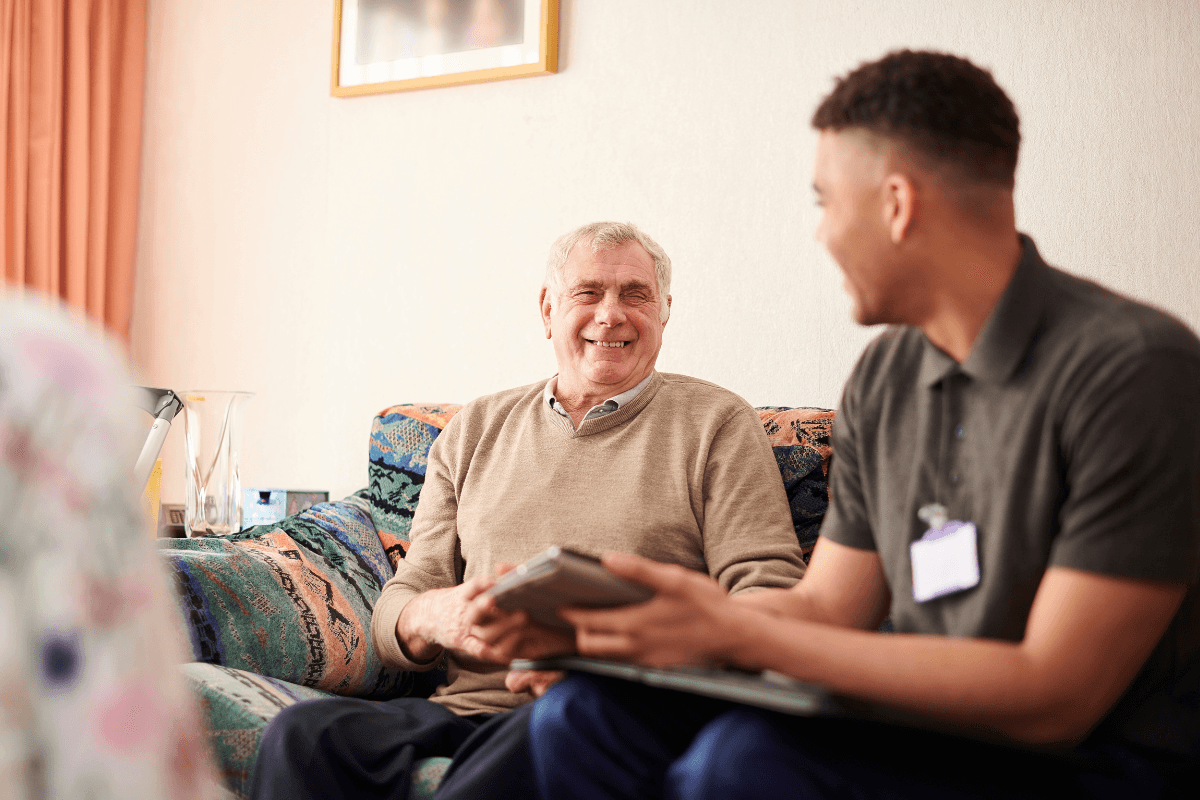Treatment Modalities and Interventions: An In-Depth Guide for 2026
Therapy is a collaborative treatment between a licensed professional—for instance, in the fields of psychology and psychiatry—and a client or patient, conducted for the purpose of alleviating emotional distress and mental health concerns. During therapy sessions, the healthcare provider and the client look into the client’s life experiences and decisions and attempt to understand each aspect involved with the help of different treatment modalities and interventions.
Many therapy modalities have been proven effective based on research and practice. Symptoms and psychological distress in adolescents lessen during treatment, mostly in the first six months (Gergov, 2021). For older adults, 52.5% recover and 72% improve (Saunders, 2021), with treatment regularity reportedly being predictive of positive results (Gergov, 2021). Researchers continue studying these treatment modalities in online graduate psychology programs.
The Research.com team wrote this in-depth guide discussing what is a modality in therapy and the purpose of the different therapy modalities. This article also dives into the importance of receiving the appropriate treatment interventions to increase patient attendance and treatment success rates. Additionally, if you are asking what can you do with a psychology major, this guide can be an excellent resource.
Treatment Modalities and Interventions Table of Contents
- Cognitive Behavioral Therapy
- Animal-assisted Therapy
- Music Therapy
- Psychodynamic Therapy
- Hypnotherapy
- Group Therapy
- Lifestyle Factors
What is a modality in therapy?
Therapy modalities are the different therapeutic techniques, approaches, or processes conducted by licensed mental health professionals to help treat and improve patients’ psychological, emotional, and social well-being. Treatment modalities and interventions have been developed over the decades. Along with this, the stigma around mental illness has been slowly dissipating as a result of the collective efforts of the medical community, advocates, and patients themselves.
Because of these advancements in the field and new ways to access mental-health services, the number of therapy clients has been increasing in recent years. Additionally, the COVID-19 pandemic has negatively affected the world in many demonstrable ways, including its mental and emotional impact on society at large. In the United States, almost 22% of adults of all ages received mental health treatment in 2021, increasing from 19.2% in 2019 and 20.3% in 2020 (Terlizzi & Schiller, US Centers for Disease Control and Prevention, 2022).
What are the different therapy modalities?
Our research team created a list of evidence-based therapy modalities below and discussed the tools, processes, and efficacy of each modality. Given that there are many types of therapy, we only focused on the most common modalities. Additionally, the details explained here can also be useful to students taking online degrees in counseling, psychology, or other related fields.
1. Cognitive Behavioral Therapy
Cognitive behavioral therapy (CBT) is a treatment modality that is aimed to change unhelpful thinking and learned behavioral patterns of patients or clients. The American Psychological Association (APA) cites the following as the core principles of CBT:
- Psychological problems are based, in part, on faulty or unhelpful ways of thinking.
- Psychological problems are based, in part, on learned patterns of unhelpful behavior.
- People suffering from psychological problems can learn better ways of coping with them, thereby relieving their symptoms and becoming more effective in their lives.
CBT allows patients to work together with their licensed mental healthcare provider to understand the issues at hand and devise a treatment strategy. Examples of CBT strategies include acknowledging and reassessing cognitive distortions and role-playing in preparation for difficult interactions that may happen.
The modality is used to treat different psychological issues, such as depression, anxiety disorders, alcohol and drug abuse problems, marital problems, and eating disorders. In the study titled “The evidence for cognitive behavioural therapy in any condition, population or context: a meta-review of systematic reviews and panoramic meta-analysis" published in Psychological Medicine in 2021, Fordham et. al found that “CBT improves [health-related quality of life], anxiety, and pain outcomes" in 10 mental conditions included in the reviews analyzed by the authors. These conditions include addiction, aggression, anxiety, psychosis, and stress.
Fordham et al. discussed: “The improvements were maintained for more than 12 months after receiving CBT and were evident if CBT was delivered through high- or low-intensity formats. CBT appears to help children and adults but there is little evidence available for older adults…This meta-review suggests CBT works, it improves the quality of life for people living with many different mental and physical conditions. For some conditions, we do not currently know precisely by how much it works only that it will provide small to moderate effects. The clinical implications of CBT producing consistent benefits which are not specific to any one condition will influence future clinical commissioning and implementation decisions."
2. Animal-assisted Therapy
Animal-assisted therapy (AAT) is a treatment intervention that ethically utilizes trained animals, such as dogs, cats, and horses, partnered with professional handlers to assist people in need. The presence of animal and patient-animal interactions may provide patients with a sense of calm and comfort during stressful situations and bouts of loneliness. This treatment modality is also being taught in some of the best child psychology programs.
AAT is used as part of treatment plans to augment conventional therapy modalities. Strategies of this modality depend on the patient, the selected animal, and the treatment goals. Together with the therapist and the animal, patients perform goal-oriented therapeutic activities with measurable objectives. The modality is conducted in individual or group settings and is documented and assessed by the involved licensed healthcare professional.
AAT helps treat various psychological conditions, including anxiety, depression, stress, addiction, and autism. This treatment intervention has been proven to have a significant effect on general anxiety, separation anxiety, generalized anxiety disorder, social anxiety, and specific anxiety in pre-school children, supporting the addition of AAT in the treatment plans of children with anxiety (Tahan et al., 2022).
Dog-assisted therapy (DAT), specifically, has been reported to help boost emotional self-regulation, attendance, and social responsiveness in children with mental disorders attending a mental health day hospital (Guzman et al., 2022). While parents and legal guardians reported no significant differences in their children before and after treatment involving DAT at the day hospital, the children’s therapists reported statistically significant differences before and after treatment.
The results were obtained through the Self-control Rating Scale (SCRS) and the Social Responsiveness Scale-2 (SRS). Patients with a minimum score of 160 in the SCRS may be recommended for treatment to work on self-control. However, the therapists scored their young patients 132.5 pre-treatment and 110.82 post-treatment on the SCRS and 139.58 pre-treatment and 135.13 post-treatment on the SRS (Guzman et al., 2022). Having a decrease in scores that were already lower than 160 indicates an improvement in the mental well-being of the children with the help of DAT.
3. Music Therapy
Music therapy (MT) is a treatment approach that utilizes music to aid in accomplishing the goals and objectives set in the treatment plan. A licensed music therapist may encourage patients to listen to (receptive MT), reflect on, and create (active MT) music in individual or group settings, complementing traditional therapy types. The benefits of this treatment intervention may include managed stress levels, improved memory, alleviated pain, physical rehabilitation, and regulated emotions, according to the American Music Therapy Association.
MT can also help in managing various physical and mental health conditions, such as heart complications, cancer, dementia, autism, and depression. Additionally, the modality was found to be effective in managing certain symptoms of schizophrenia, Parkinson’s disease, and other serious mental disorders aside from improving sleep quality (Kamioka et al., 2014). This is why psychology job opportunities may look for applicants that know how to properly implement music therapy.
Additionally, MT has been proven to be beneficial to patients diagnosed with dementia and insomnia as it is secure, easily accessible, and helpful in improving their physical, mental, and social health (Gassner, Geretsegger, & Mayer-Ferbas, 2022). Qualified and, if applicable, accredited music therapists are recommended for active MT sessions, while healthcare professionals, such as nurses and those trained in MT, may provide patients with receptive MT approaches.
4. Psychodynamic Therapy
Psychodynamic therapy is a comprehensive form of talk therapy—based on the theories, principles, and practice of psychoanalytic therapy—wherein the patient dives into the psychological causes of emotional suffering with the help of a licensed mental healthcare provider. The patient is encouraged to self-reflect and self-examine to uncover and understand personal relationship patterns.
Psychodynamic therapy concentrates more on the patient’s relationship with external environments rather than the patient’s relationship with the therapist. The modality is used to help with various mental health issues, including depression and anxiety, and has seven distinct features of process and technique (Shedler, 2010):
- Focus on affect and expression of emotion
- Exploration of attempts to avoid distressing thoughts and feelings
- Identification of recurring themes and patterns
- Discussion of past experiences (developmental focus)
- Focus on interpersonal relations
- Focus on the therapy relationship
- Exploration of fantasy life
Research has found that psychodynamic therapy has lasting positive outcomes that extend beyond treatment periods. By exploring the thoughts, feelings, experiences, and relationships of patients, symptoms of mental conditions may be alleviated over time and after treatment (Shedler, 2010). A major meta-analysis of this therapy modality (Abbass, Hancock, Henderson, & Kisely, 2006) has seen a 50% growth in effect size—the amount of change brought about by each treatment—at least nine months after the end of treatment. The treatments observed were usually conducted once a week for less than one year.
In the meta-analysis, psychodynamic therapy had a significantly large effect size and reportedly outperforms well-established antidepressant medications, given that an effect size of 0.80 is considered large in research in the field, according to the APA, and psychodynamic therapy revealed an effect size of 0.97 for general symptom improvement. Notably, the post-treatment evaluation showed that its effect size grew to 1.51. In contrast, the effect size for the most widely used antidepressants is 0.31 (Abbass, Hancock, Henderson, & Kisely, 2006).
Additionally, assessments on psychotherapeutic and psychoeducative group interventions revealed statistical improvements in the general psychological health and trauma symptoms of children exposed to intimate partner violence (IPV) between the pre-treatment evaluation and six months after the end of treatment. Sustained positive changes were found at the 12-month post-treatment follow-up. Based on the Trauma Symptom Checklist for Young Children (TSCYC), a significant reduction in percentage of young patients with the following trauma symptoms, among other areas, were reported after six months post-treatment (Pernebo, Fridell, & Almgvist, 2019):
- Anxiety (from 62% to 28%)
- Depression (from 52% to 12%)
- Aggression (from 56% to 28%)
- Total post-traumatic stress (from 76% to 36%)
5. Hypnotherapy
Hypnotherapy or hypnosis is a treatment intervention that uses verbal repetition and mental images to place a patient in a state of awareness and relaxation, helping boost the patient’s concentration. Hypnosis may be utilized for behavioral change, pain control, and anxiety relief.
Deep relaxation brought about by hypnosis may be easy for most people to enter into and get out of. According to Stanford University psychiatrist Dr. David Spiegel in a 2022 Time article, the hypnotic state is similar to a flow state. It allows an individual to be completely focused and immersed in an activity. People in the hypnotic state tend to be more open to suggestions for behavioral change.
When performed by a certified healthcare professional, hypnosis is a safe alternative therapy modality—except for some individuals with severe mental illness—and is usually combined with other therapy types to form a patient’s treatment plan. Rare harmful reactions to this treatment intervention may include dizziness, nausea, and anxiety or distress.
A 2018 study concluded that the effectiveness of hypnotherapy in treating anxiety disorders remains uncertain due to insufficient evidence and scarce quality methodologies and research (Trumm, 2018). However, cognitive developmental hypnotherapy has been found to increase an individual’s sense of self and derivation of meaning from life. It also helps improve the quality of life of married women by reducing their marital conflicts through techniques, including fostering and empowering the ego (Toosi et al., 2022).
6. Group Therapy
Group therapy is a treatment modality that involves one or more licensed mental healthcare providers leading a group of a minimum of five patients, meeting for one to two hours weekly. Recognized by the APA in 2018 as an official specialty and area of practice, group therapy is used to help address psychological issues, such as depression, social anxiety, and panic disorder, as well as social concerns, such as low self-esteem, shyness, and loneliness. This therapy type can also help individuals who have experienced loss, including the death of a spouse or a child. Moreover, it is also a well-practiced treatment used by a professional working as a correctional psychologist.
Three decades of research recommend group therapy for treating various issues and reveal results similar to those of individual therapy (Rosendahl et al., 2021). Studies have shown that the effects of this treatment intervention, such as decreased cortisol levels and depression, can last long-term in cancer patients (Antoni et al., 2016).
Group therapy may also provide patients with a network of support and feedback to aid in treatment, which has been shown to result in significant improvement among patients (Newnham et al., 2010) and positive effects five days into a short-term, daily treatment (Schuman et al., 2015; Slone et al., 2015). The therapeutic relationship has also been reported as a predictor of outcome improvement. A 2018 study found that 35% of its 432 participants of 58 groups at university counseling centers reported becoming off course for therapeutic treatment success at least once due to the lack of therapeutic-relationship feedback. This was despite progress feedback being provided (Burlingame et al., 2018). Feedback seemed to help strengthen relationships between therapists and groups of patients as well as decrease treatment-failure rates (Rosendahl et al., 2021).
The number of patients affected by mental illnesses has fluctuated over the course of the COVID-19 pandemic. The demand for different treatment modalities and interventions increased between 2020 and 2021 for the following areas (American Psychological Association, 2022).
- Anxiety disorders (from 74% to 83%)
- Depressive disorders (from 60% to 72%)
- Trauma- and stressor-related disorders (from 51% to 62%)
- Sleep-wake disorders (from 48% to 53%)
- Obsessive-compulsive and related disorders (from 31% to 42%)
- Substance-related and addictive disorders (from 29% to 43%)
- Feeding and eating disorders (from 20% to 28%)
The figures for 2022 continue to show that demand remains high for effective treatment options despite patient cases decreasing between 2021 and 2022 for the following treatment areas (American Psychological Association, 2022):
- Anxiety disorders (down to 79%)
- Depressive disorders (down to 66%)
- Sleep-wake disorders (down to 49%)
- Feeding and eating disorders (down to 27%)

How Do Continuing Education and Advanced Training Enhance Therapy Practices?
Staying current with emerging research and innovative treatment methods is critical for advancing therapy practices. Engaging in ongoing education enables mental health professionals to refine their clinical skills, integrate cutting‐edge, evidence-based interventions, and respond effectively to evolving client needs. Advanced training programs and specialized courses foster a deeper understanding of novel therapeutic modalities and technological advancements, which ultimately contribute to more dynamic and effective treatment outcomes. Moreover, the flexibility of digital learning platforms allows practitioners to enhance their credentials and broaden their expertise through curated programs such as fast online degrees, ensuring their practice remains at the forefront of the psychotherapeutic field.
The Importance of Getting the Right Treatment
Finding the right therapy modality and a good match when it comes to certified healthcare providers is important to long-lasting positive effects and improvement in patient health. When exploring intervention options, it is essential to understand the goals of psychology, what is the main purpose of therapeutic modalities, and patient preferences.
Therapy modalities are not a one size fits all solution. For instance, hypnotherapy might work for one patient but not for another, or music therapy may be preferred by a client who is musically inclined but not by those who do not enjoy music.
Additionally, individuals undergoing therapy must ensure that the healthcare providers they are working with are expertly trained and certified in the treatment modality in progress. In turn, healthcare providers are largely responsible for improving therapy attendance rates. Inconsistent attendance or absences by outpatient clients were found to be mainly caused by the mental conditions that urged the patients to seek treatment, with clients reporting uncertainty about the treatment goals, therapeutic methods, patient responses to treatment, and successful treatment outcomes (Granås, Strand, & Sand, 2022).
The importance of a strong therapeutic relationship is also evident as conversations with the healthcare professional about the inconsistency of patient attendance are lacking while absences continue without mention or resolution. Some cases may require evaluation by both therapists and patients to know if non-attendance may be resolved by switching to a therapy modality that may be better suited to the patients. Like many things in life, the appropriate treatment and therapist may be found by trial and error. Asking a trusted family member, friend, or mentor about recommendations may be a good starting point.
Are there inherent risks and safety considerations in therapy modalities?
Evaluating potential risks and establishing robust safety measures are essential for any therapeutic approach. Clients should be informed of possible adverse effects, and therapists must adhere to strict ethical standards and informed consent processes. Clear communication regarding treatment objectives, session structure, and emergency protocols enhances the overall safety of therapy. Additionally, ongoing professional development—including pursuing certifications that pay well—ensures that practitioners remain updated on best practices and regulatory requirements, ultimately safeguarding both client well-being and treatment integrity.
What Undergraduate Degree Best Prepares You for a Career in Therapy?
A robust undergraduate education offers the critical foundation needed for clinical insight and therapeutic innovation. Choosing a degree program that emphasizes core psychological theories, research methodologies, and practical applications can streamline the transition into advanced therapy training. Students can further enhance their practical skills by engaging in research projects, internships, and networking opportunities within the mental health field. For those seeking an accessible starting point, programs like the easiest undergraduate degree can provide essential coursework and exposure, ultimately better equipping graduates for specialized certifications and clinical practice.
Are Accelerated Doctoral Programs a Worthwhile Investment for Therapy Professionals?
Pursuing an accelerated doctoral program can enhance clinical expertise, research acumen, and the integration of innovative evidence-based practices. Such programs offer intensive training and hands-on clinical experiences that rapidly equip professionals with advanced skills to address complex therapy needs. Moreover, a rigorous curriculum reinforces credibility and fosters leadership in clinical settings, ultimately contributing to improved therapy outcomes. For a focused pathway to advanced credentials, consider enrolling in one year doctoral programs.
Can Early Career Education and Mentorship Drive Therapy Success?
A robust early career foundation, anchored in rigorous academic training and structured mentorship, equips future therapists with critical clinical skills and real-world insights. Engaging in specialized undergraduate programs and immersive research or internship experiences can enhance analytical proficiency and adaptive problem-solving in clinical settings. Practical mentorship from experienced professionals further guides early practitioners in navigating emerging challenges and integrating evidence-based practices into their work. For instance, enrolling in programs that offer curricula aligned with the highest paying bachelor degrees entry-level can provide a competitive advantage while fostering professional growth and long-term career resilience.
How do lifestyle factors influence the success of therapy?
In addition to the chosen therapeutic modality, lifestyle factors play a significant role in the effectiveness and success of therapy. While often overlooked, these elements can greatly impact an individual's progress and overall well-being during treatment:
- Sleep patterns: Quality sleep is essential for cognitive function and emotional regulation. Sleep deprivation can exacerbate mental health symptoms such as anxiety and depression, making it harder for therapy to be effective.
- Nutrition: A balanced diet supports mental clarity and emotional stability. Nutritional deficiencies, such as low levels of omega-3 fatty acids, have been linked to increased rates of depression and anxiety.
- Physical activity: Regular exercise has been shown to boost mood, reduce symptoms of anxiety and depression, and enhance overall cognitive function, making individuals more receptive to therapeutic interventions.
- Social support: Having a network of supportive friends or family can improve emotional resilience and provide a sense of security, helping clients feel more empowered to apply therapeutic techniques outside of sessions.
- Stress management: High levels of chronic stress can hinder the therapeutic process. Implementing stress-reducing practices, such as mindfulness or relaxation techniques, can improve therapy outcomes.
- Substance use: Excessive use of alcohol or drugs can interfere with mental health progress, making it harder for clients to benefit fully from therapy. Addressing substance use is often necessary to enhance treatment effectiveness.
How to Choose the Right Therapy Modality for You
Understanding your needs and preferences: Each person’s mental health journey is unique. Before selecting a therapy modality, reflect on your personal goals, emotional challenges, and preferences. For instance, if you are drawn to creative expression, you might explore music or art therapy, whereas someone seeking structured, evidence-based techniques might consider Cognitive Behavioral Therapy (CBT). Additionally, pursuing further education, such as an online master's in social work, can provide deeper insights into different modalities and help you make more informed decisions about mental health approaches.
Consulting with a professional: A licensed mental health professional can help you assess your specific needs and recommend a modality tailored to your situation. During an initial consultation, openly discuss your symptoms, expectations, and any concerns about treatment.
Considering practical factors: Logistical aspects such as cost, availability, and session format (in-person vs. online) play a role in determining the right fit. For example, group therapy may be a more affordable option, while hypnotherapy might require access to a specialized provider.
Evaluating progress and flexibility: Therapy is a process, and it’s essential to periodically evaluate its impact. If a particular modality isn’t yielding the desired results, don’t hesitate to discuss alternatives with your therapist. Many individuals benefit from combining multiple modalities for a comprehensive approach to mental health care.
How Do Therapist Qualifications and Certifications Impact Therapy Outcomes?
Therapist qualifications and certifications ensure adherence to rigorous professional standards and up-to-date practices. Verifying credentials not only reinforces trust in therapeutic effectiveness but also correlates with improved patient outcomes. Mental health professionals committed to continuous education and specialty training have access to advanced methodologies and tools that can enhance individualized care. For instance, pursuing certifications that pay well may provide additional expertise and financial incentives to maintain best practices. This dedicated professional development fosters higher treatment consistency and strategic use of evidence-based interventions, ultimately contributing to more sustainable and positive patient progress.
Can Online Education Effectively Prepare Mental Health Professionals?
With the rapid expansion of digital learning, many prospective mental health professionals now obtain their credentials through online programs. Recent studies and accreditation standards confirm that well-structured online curricula provide comprehensive training, blending theoretical knowledge with practical application to meet industry benchmarks. Evidence indicates that graduates from accredited online programs, as seen in institutions that are online degrees credible, possess the necessary competencies and critical thinking skills to deliver high-quality care. This modern educational pathway supports innovative treatment methods and fosters continual professional development in a dynamic clinical environment.
Evolve with the Ever-developing Psychotherapeutic Field
Psychotherapy is an ever-developing field of research and practice. For successful and sustainable treatment options and outcomes, researchers must continue to produce evidence-based clinical research studies, while clinical practitioners must further develop their procedures with the support of these empirical studies. The best psychology journals and globally recognized organizations, including the World Health Organization, the American Psychological Association, the American Psychiatric Association, are credible sources of information on mental health, which professionals and ordinary citizens alike may find beneficial to their everyday life.
Key Insights
- Therapy Effectiveness: Research indicates that therapy is effective across various demographics, with adolescents experiencing symptom reduction within six months and older adults showing a 52.5% recovery rate.
- Increasing Demand: The COVID-19 pandemic has heightened the demand for mental health services, with nearly 22% of US adults receiving treatment in 2021, up from previous years.
- Diverse Modalities: There are numerous therapy modalities available, each with unique approaches and efficacy, including Cognitive Behavioral Therapy, Animal-assisted Therapy, Music Therapy, Psychodynamic Therapy, Hypnotherapy, and Group Therapy.
- Modality Selection: The choice of therapy modality should consider individual patient needs and preferences, as well as the expertise of the healthcare provider.
- Positive Outcomes: Effective therapy can lead to lasting improvements in mental health, with modalities like psychodynamic therapy showing benefits that extend beyond the treatment period.
- Role of Therapeutic Relationship: A strong therapeutic relationship and regular attendance are crucial for successful therapy outcomes. Inconsistent attendance can hinder progress and may necessitate a change in the therapy approach.
- Empirical Support: Continued research and evidence-based practice are essential for advancing the field of psychotherapy and improving treatment outcomes.
FAQ
- What is the purpose of therapy? Therapy aims to alleviate emotional distress and mental health concerns through collaborative treatment between a licensed professional and a client. It involves exploring the client's life experiences and decisions to understand and address underlying issues.
- How effective is therapy for different age groups? Therapy is effective for various age groups, with adolescents showing symptom reduction within six months and older adults experiencing a 52.5% recovery rate and a 72% improvement rate.
- What are some common therapy modalities? Common therapy modalities include Cognitive Behavioral Therapy (CBT), Animal-assisted Therapy (AAT), Music Therapy (MT), Psychodynamic Therapy, Hypnotherapy, and Group Therapy. Each modality has unique approaches and is effective for different psychological conditions.
- How has the COVID-19 pandemic affected mental health treatment? The COVID-19 pandemic has increased the demand for mental health treatment, with the percentage of adults receiving treatment rising from 19.2% in 2019 to nearly 22% in 2021. This increase highlights the pandemic's significant mental and emotional impact.
- What is Cognitive Behavioral Therapy (CBT)? Cognitive Behavioral Therapy (CBT) is a treatment modality aimed at changing unhelpful thinking and behavior patterns. It is effective for various psychological issues, including depression, anxiety, and addiction, and focuses on teaching patients better coping mechanisms.
- How does Animal-assisted Therapy (AAT) work? Animal-assisted Therapy (AAT) involves using trained animals, such as dogs and horses, in therapeutic settings to provide patients with a sense of calm and comfort. It is used to treat conditions like anxiety, depression, and autism, often as a complement to conventional therapy.
- What are the benefits of Music Therapy (MT)? Music Therapy (MT) uses music to achieve treatment goals, such as stress management, improved memory, and emotional regulation. It is effective for conditions like dementia, schizophrenia, and depression, and can be delivered through active or receptive methods.
- What is the focus of Psychodynamic Therapy? Psychodynamic Therapy is a talk therapy that explores the psychological causes of emotional suffering. It focuses on the patient's relationship with their environment and aims to uncover patterns in thoughts, feelings, and experiences to alleviate mental health symptoms.
- What are the potential benefits of Hypnotherapy? Hypnotherapy uses verbal repetition and mental images to induce a state of relaxation and concentration. It is used for behavioral change, pain control, and anxiety relief. While its effectiveness for anxiety disorders needs more research, it has shown benefits in improving self-perception and marital relationships.
- How does Group Therapy work, and what are its benefits? Group Therapy involves one or more therapists leading a group of patients to address psychological and social issues. It provides a support network and feedback, which can lead to significant improvements in conditions like depression and anxiety, and can offer long-term benefits.
References
- Abbass, A. A., Hancock, J. T., & Kisely, S. (2006). Short-term psychodynamic psychotherapies for common mental disorders. Cochrane Database of Systematic Reviews. https://doi.org/10.1002/14651858.cd004687.pub3
- Fordham, B. et al. (2021, January 18). The evidence for cognitive behavioural therapy in any condition, population or context: a meta-review of systematic reviews and panoramic meta-analysis. Psychological Medicine, 51(1). https://www.cambridge.org/core/journals/psychological-medicine/article/evidence-for-cognitive-behavioural-therapy-in-any-condition-population-or-context-a-metareview-of-systematic-reviews-and-panoramic-metaanalysis/3BE55E078F21F06CFF90FFAD1ACEA5E0
- Gassner, L., Geretsegger, M., & Mayer-Ferbas, J. (2022, February). Effectiveness of music therapy for autism spectrum disorder, dementia, depression, insomnia and schizophrenia: update of systematic reviews. European Journal of Public Health 32(1:2734). https://doi.org/10.1093/eurpub/ckab042
- Gergov, V. (2021, February 16). Effectiveness and Predictors of Outcome for Psychotherapeutic Interventions in Clinical Settings Among Adolescents. Frontiers in Psychology 12. https://doi.org/10.3389/fpsyg.2021.628977
- Granås, J., Strand, J., & Sand, P. (2022, July 11). A patient perspective on non-attendance for psychotherapy in psychiatric outpatient care for patients with affective disorders. Nordic Psychology. https://doi.org/10.1080/19012276.2022.2093777
- Guzman, E. G. et al. (2022, October 19). The Benefits of Dog-Assisted Therapy as Complementary Treatment in a Children’s Mental Health Day Hospital. Animals 12(2841). https://doi.org/10.3390/ani12202841
- Kamioka, H. (2014). Effectiveness of music therapy: a summary of systematic reviews based on randomized controlled trials of music interventions. Patient Preference and Adherence 8(727754). https://doi.org/10.2147%2FPPA.S61340
- Pernebo, K., Fridell, M., & Almgvist, K. (2019, July). Reduced psychiatric symptoms at 6 and 12 months’ follow-up of psychotherapeutic and psychoeducative group interventions for children exposed to intimate partner violence. Child Abuse & Neglect 93(228238). https://doi.org/10.1016/j.chiabu.2019.05.002
- American Psychological Association. (2022). Psychologists struggle to meet demand amid mental health crisis: 2022 COVID-19 Practitioner Impact Survey. https://www.apa.org/pubs/reports/practitioner/2022-covid-psychologist-workload
- Rosendahl, J. et al. (2021, March 22). Recent Developments in Group Psychotherapy Research. The American Journal of Psychotherapy 74(2:5259). https://doi.org/10.1176/appi.psychotherapy.20200031
- Saunders, R. (2021, November 1). Older adults respond better to psychological therapy than working-age adults: evidence from a large sample of mental health service attendees. Journal of Affective Disorders 294(8593). https://doi.org/10.1016/j.jad.2021.06.084
- Tahan, M. et al. (2022, August). Assessing the effectiveness of animal-assisted therapy on alleviation of anxiety in pre-school children: A randomized controlled trial. Contemporary Clinical Trials Communications 28(100947). https://doi.org/10.1016/j.conctc.2022.100947
- Terlizzi, E. P. & Schiller, J. S. (2022, September). Mental Health Treatment Among Adults Aged 1844: United States, 20192021. Centers for Disease Control and Prevention, National Center for Health Statistics. https://www.cdc.gov/nchs/products/databriefs/db444.htm
- Toosi, F. M. et al. (2022, January 10). The effectiveness of cognitive developmental hypnotherapy on differentiation of self, meaning in life and marital conflicts in married women. American Journal of Clinical Hypnosis 64(3:248262). https://doi.org/10.1080/00029157.2021.1964425
- Trumm, A. (2018, September). Effectiveness of Hypnotherapy in Anxiety Disorders: A Systematic Review. http://dx.doi.org/10.13140/RG.2.2.33559.32169
- American Psychological Association. What is Cognitive Behavioral Therapy? https://www.apa.org/ptsd-guideline/patients-and-families/cognitive-behavioral
- American Music Therapy Association. What is Music Therapy? https://www.musictherapy.org/about/musictherapy


































